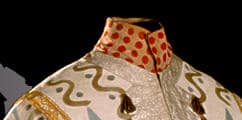





One of the key ingredients of the Russian Ballet's early success in western Europe was its 'Russianness': the way the productions corresponded with a popular image of Russia as a wild, untamed and primitive place. The Polovtsian Dances from Prince Igor 1909 was the company's first popular hit in Paris. Nicholas Roerich's earth-smeared set and vibrant costumes, Alexander Borodin's stirring music and the vigorous choreography of Michel Fokine shattered the refined traditions of ballet.
Aleksandr Golovin adapted the rich patterning of Russian handicrafts and folk art for his designs for The Firebird 1910. Fokine worked closely with Igor Stravinsky to harmonise the movements with the score. The production was praised for its magical synthesis of dance, design and music.
The Rite of Spring 1913, a ballet culminating in the ritual sacrifice of a young virgin, marked the company's modernity. Stravinsky's score overturned musical conventions while Vaslav Nijinsky's choreography was considered violent and offensive. Roerich's costumes, with their crudely stencilled patterns, echoed the primeval mood of the ballet.
Natalia Goncharova, a leader of the Moscow avant-garde, used popular and traditional imagery to reinvigorate modern art. Her exuberant designs for The Golden Cockerel 1914, with their odd perspectives, strange proportions and irrepressibly bright colours, drew on the florid patterning of Russian peasant art.